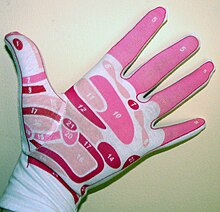Reflexology
The reflex zone massage is a form of treatment which, in its therapeutic form , is counted among the alternative medical treatment methods and which is also used in the wellness industry. Proponents of the method assume that reflex zone massages in pain therapy and for circulatory disorders can complement conventional medical procedures and physiotherapeutic applications and support an improvement in wellbeing. According to scientific studies, reflexology is largely ineffective . There are an estimated 25,600 reflexology providers in the EU .
Reflex zones
The reflex zones in the body referred to in reflexology are intended to "mirror" all organs and muscle groups on the surface of the skin and in the subcutaneous area. They are not identical to the familiar head zones in medicine. It should be on the back, on the foot, on the hand, on the ear, on the nose and on the skull. These zones should be able to be used either diagnostically ( iris diagnosis ) or in the context of a diagnosis or therapeutically (reflexology, acupuncture and acupressure ).
The terms reflex zone and somatotopia are often used synonymously. A body area is generally referred to as a reflex zone which, due to a hypothetical, not precisely described reflex-like interaction, is perceived to be diagnostically and therapeutically useful. The term somatotopia, on the other hand, has a phenomenological reference: it describes the quasi-cartographic representation of the entire organism on one of its sub-areas. The usability of many somatotopias as reflex zones and the interpretation of many reflex zones as somatotopias mean that the two terms are generally understood to be interchangeable.
There is no uniform representation of the reflex zones - for example on the feet and hands, instead there are many different, contradicting images.
history
Basically, the foot reflex zone treatment is known in the Far Eastern massage traditions: it can be found in the Ayurvedic massage tradition as well as in the historical Thai massage and the Chinese Tuina . The American ear, nose and throat doctor William Fitzgerald (1872–1942) is considered to be the pioneer of the newer western reflexology . He had knowledge of the methods of Indian folk medicine . This includes ideas about reflective connections and pressure treatment, which are said to have been used for centuries and are also currently used in Indian reservations.
Fitzgerald then developed a system in which he divided the body into ten vertical zones. This concept and the zone therapy developed by it were the cornerstone of today's reflex zone therapy in 1917. These longitudinal zones were later divided into three transverse zones each. The American masseuse Eunice D. Ingham (1889–1974) worked out the grip and pressure techniques of modern foot reflexology therapy in the middle of the 20th century. Reflexology came from America to Germany via England.
The foot reflex zone therapy is part of the standard offer in alternative practitioner schools and massage schools. Today it is mainly non-medical practitioners , physiotherapists and masseurs who work with this form of therapy: These are massages in which pressure-sensitive zones are stimulated for diagnosis and by mechanical or other stimulation ( low-level laser therapy , color emitters, colored pads , gemstones, etc.). In addition to the foot reflex zone therapy reserved for the healing professions, a foot reflex zone massage is used in the wellness area, which above all has a relaxing effect.
effectiveness
Some supporters of reflex zone therapy start from the hypothesis that the energy channels of traditional Chinese medicine as meridians are responsible for the effectiveness of the reflex zones . However, there is no scientific evidence for the meridians.
A systematic review found a therapeutic effect in only one of five studies and therefore does not consider reflex zone therapy to be recommended.
See also
literature
- Martine Faure-Alderson: Total reflex zone therapy. AT Verlag, Aarau 2011, ISBN 978-3-03800-538-4 .
- Eunice D. Ingham: Stories that the feet tell. 2 volumes. Three oaks, Hammelburg 2002, ISBN 978-3-76990-544-1 .
- Bernard C. Kolster, Astrid Waskowiak: Knaur's Atlas of Reflex Zone Therapy . Weltbild, Augsburg 2005, ISBN 978-3-898-97148-5 .
- Hanne Marquardt: Practical textbook of reflex zone therapy on the foot. Hippokrates, 5th edition, Stuttgart 2001, ISBN 3-7773-1784-5 .
- Günther Quilitzsch: Manual segment therapy - a modern reflex zone massage. Müller & Steinicke, Munich 1986, ISBN 3-87569-077-X .
- Chris Stormer: Reflexology. Hodder & Stoughton, Dunton Green (Great Britain) 1992
- German edition: Reflexology. Translated from English by Clemens Wilhelm. Dromer Knaur, Munich 1994, ISBN 3-426-76052-5 .
Web links
- Reflexology Association of America (English)
- Colin Goldner: A whole body on the sole of the foot. In: sueddeutsche.de . May 10, 2010, accessed February 10, 2011
Individual evidence
- ↑ a b Mei-Yeh Wang, Pei-Shan Tsai, Pi-Hsia Lee, Wen-Yin Chang, Che-Ming Yang: The efficacy of reflexology: systematic review . In: Journal of Advanced Nursing . tape 62 , no. 5 , June 2008, p. 512-520 , doi : 10.1111 / j.1365-2648.2008.04606.x .
- ↑ K. von Ammon, M. Frei-Erb, F. Cardini, U. Daig, S. Dragan, G. Hegyi, P. Roberti di Sarsina, J. Sörensen, G. Lewith: Complementary and alternative medicine provision in Europe– first results approaching reality in an unclear field of practices. In: Researching complementary medicine (2006). Volume 19 Suppl 2, 2012, pp. 37-43, doi : 10.1159 / 000343129 , PMID 23883943 (review).
- ↑ Chris Stormer: Reflexology. Dromer Knaur, Munich 1994, p. 11.

